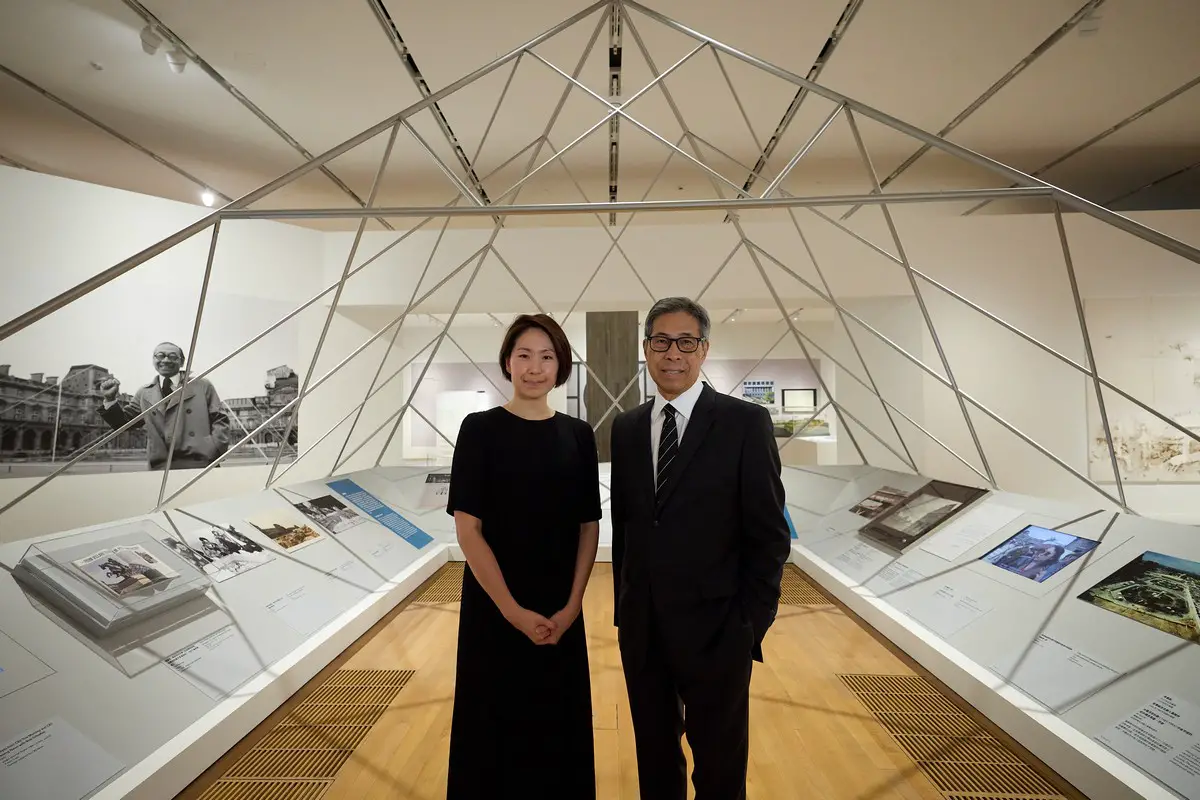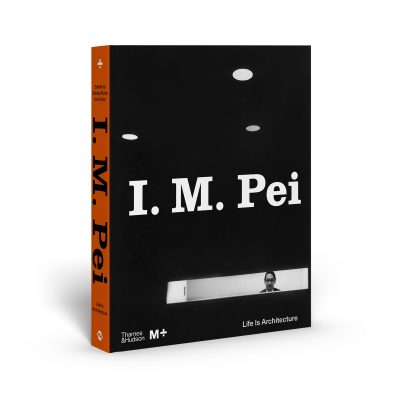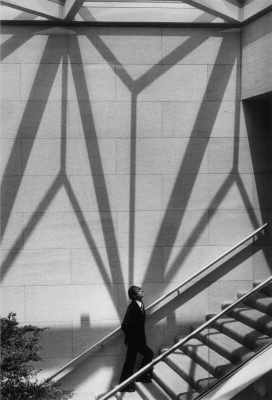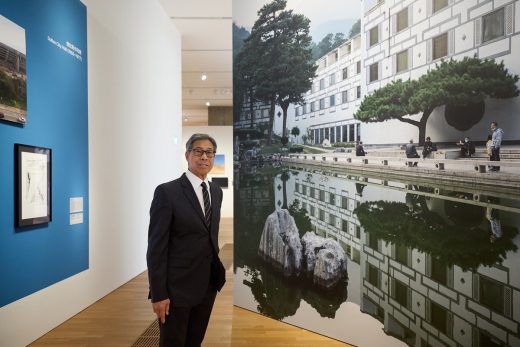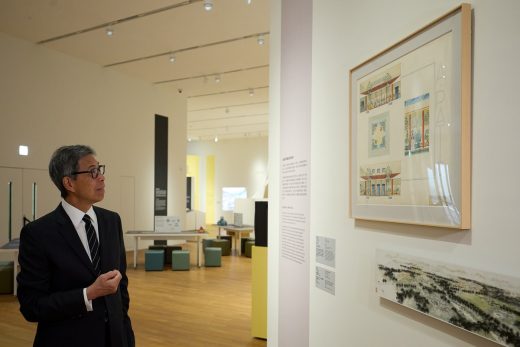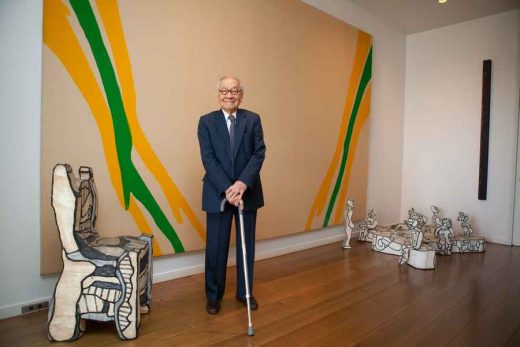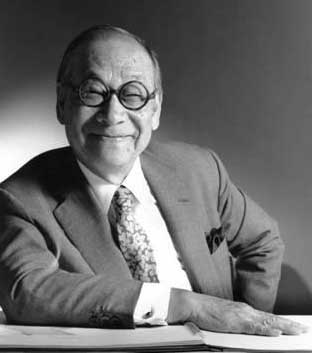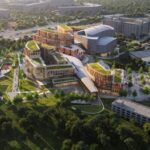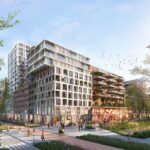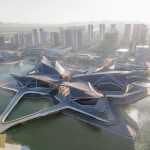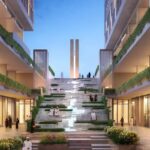I. M. Pei: Life Is Architecture, US architect Ieoh Ming M+ Special Exhibition, Architectural studio
I. M. Pei: Life Is Architecture
26 June 2024
M+ Special Exhibition I. M. Pei: Life Is Architecture, the first full-scale retrospective of world-renowned architect Ieoh Ming Pei, opens to the public this Saturday 29 June 2024.
Architect Li Chung (Sandi) Pei at the M+ exhibition:
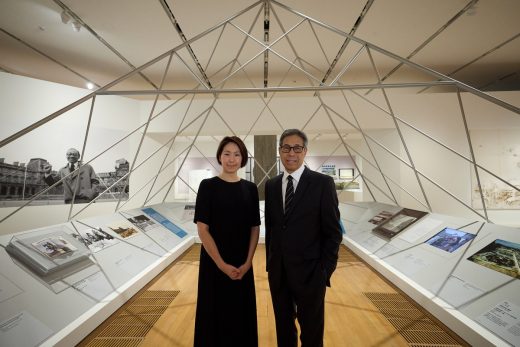
photos : Wilson Lam. Images courtesy of M+, Hong Kong
I. M. Pei: Life Is Architecture, M+ Exhibition, Hong Kong
(26 June 2024, Hong Kong) M+, Asia’s first global museum of contemporary visual culture in the West Kowloon Cultural District in Hong Kong, will present I. M. Pei: Life Is Architecture, the first full-scale retrospective of Chinese American architect Ieoh Ming Pei (1917–2019), widely known as I. M. Pei, one of the most influential architects of the twentieth and twenty-first centuries. Generously supported by the Lead Sponsor Bank of China (Hong Kong), this Special Exhibition will open to the public from Saturday 29 June 2024 to Sunday 5 January 2025 in the museum’s West Gallery.
US architect Ieoh Ming Pei:
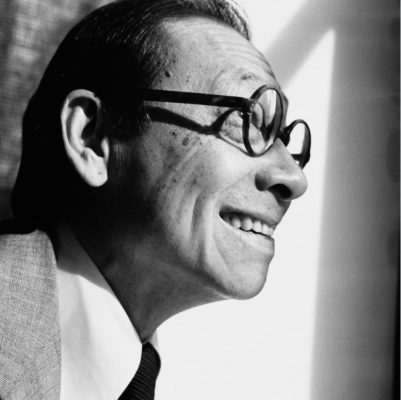
Portrait of I. M. Pei, 1976, Irving Penn, Vogue © Condé Nast
The first full-scale retrospective of I. M. Pei
I M Pei’s high-profile projects were realised over seven decades with an exceptionally wide geographic reach, including the National Gallery of Art East Building in Washington, D.C., the modernisation of the Grand Louvre in Paris, the Bank of China Tower in Hong Kong, and the Museum of Islamic Art in Doha. These landmark projects solidified his legacy and position in architectural history and popular culture. His life and work weave together a tapestry of power dynamics, geopolitical complexities, and cultural traditions around the world. His transcultural vision laid the foundation for the contemporary world.
Organised with the support of the Estate of I. M. Pei and Pei Cobb Freed & Partners, which succeeded the architectural firm Pei founded, the exhibition is curated by Shirley Surya, Curator, Design and Architecture, M+, and Aric Chen, General and Artistic Director, Nieuwe Instituut (New Institute), Rotterdam. Seven years in the making, this retrospective features more than 400 objects, many of them never exhibited before. These include original drawings, architectural models, photographs, films, and other archival documentation from institutional and private holdings.
Architect Li Chung (Sandi) Pei at M+:
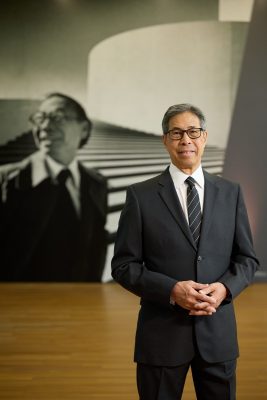
The exhibition takes a close look at Pei’s life and work through six areas of focus that not only define his unique practice, but also place his architectural projects in dialogue with social, cultural, and biographical trajectories, showing architecture and life to be inseparable. These areas are:
- Pei’s Cross-Cultural Foundations shows how Pei’s upbringing and architectural education formed the foundation of his ability to reconcile multiple sources of influence across cultures and between tradition and modernity.
- Real Estate and Urban Redevelopment unveils a lesser-known phase of Pei’s career as part of real estate developer Webb & Knapp in New York City. It explores his contributions to mixed-use planning, housing, and urban revitalisation projects in the United States in the 1960s, and subsequently beyond American borders.
- Art and Civic Form introduces Pei’s museum designs and his frequent collaborations with artists from Henry Moore to Zao Wou-Ki. The section demonstrates his belief in museums as civic spaces, the importance of dialogue between art and architecture, and his deep affinity with the contemporary art of his time.
- Power, Politics, and Patronage reveals how Pei—with his technical mastery, ingenious problem-solving, and sensitivity to client needs—became a trusted collaborator in high-profile commissions that drew both immense support and public controversy throughout his career.
- Material and Structural Innovation illustrates Pei and his team’s consistent inventiveness in the use of materials and construction methods, especially with concrete, stone, glass, and steel.
- Reinterpreting History through Design examines Pei’s long-standing interest in making modern architecture relevant to different histories, traditions, and ways of life, particularly those related to his birthplace. Pei distilled the essence of cultural and historical archetypes to provide formal or spatial strategies for contemporary needs.
Architect Li Chung (Sandi) Pei:
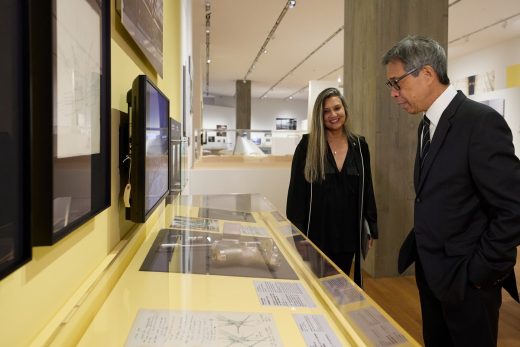
To engage a new generation of architecture students with the work of I. M. Pei, M+ has partnered with two master’s programmes at the University of Hong Kong Department of Architecture and The Chinese University of Hong Kong School of Architecture, which focus on the design of tall structures and cultural spaces, respectively. Students have contributed to creating five models in their studios of some of Pei’s most significant built and unbuilt projects. The projects include ‘Museum of Chinese Art for Shanghai’ (1946, unbuilt), his master’s thesis for Harvard University’s Graduate School of Design; Hyperboloid (1954–1956, unbuilt), New York; and Luce Memorial Chapel (1954–1963), Tunghai University, Taichung.
Architect Li Chung (Sandi) Pei:
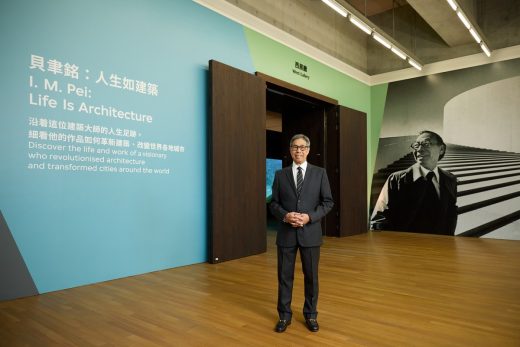
The exhibition also features newly commissioned photographs of eleven of Pei’s built projects by seven international photographers, taken during the pandemic, to reconsider the enduring influence of Pei’s work. The photographers are South Ho Siu Nam (Hong Kong), Naho Kubota (New York City), Lee Kuo-Min (Taipei), Giovanna Silva (Milan), Mohamed Somji (Dubai), Tian Fangfang (Shanghai), and Tomoko Yoneda (Tokyo/London).
Architect Li Chung (Sandi) Pei:
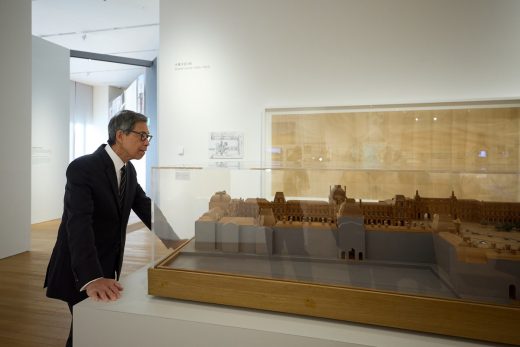
Suhanya Raffel, Museum Director, M+, says, ‘Few lives embody the vision of transcultural exchange at the heart of M+ as thoroughly and elegantly as that of I. M. Pei. We are honoured to host the first full-scale retrospective devoted to the legendary architect, whose work shaped the built environment for the twentieth and twenty-first centuries. This project reintroduces Pei and his contributions to a contemporary audience worldwide while bringing to the surface important facets of his career that have long been overlooked.’
I. M. Pei’s son, the architect Li Chung (Sandi) Pei, partner and founder of PEI Architects, says, ‘This exhibition brings to the public the first full-scale retrospective of our father’s productive and far-reaching career, elucidating the transcultural influences and distinctive historical circumstances that contributed to his unique place as an architect and global citizen. Gathered over many years from a multitude of sources, the exhibition details a remarkable personal story that only in its full telling reveals the complexities, challenges, and achievements of his long and optimistic life. We are proud of this exhibition and thank the M+ team for its thorough, intelligent, and enlightened documentation.’
Doryun Chong, Deputy Director, Curatorial, and Chief Curator, M+, says, ‘This exhibition is the result of years of research into original archival materials documenting Pei’s outstanding career. It follows the trajectory of his work across the world, highlighting his long-lasting impact on architecture today. This exhibition epitomises M+’s focus on Asia through a transnational framework. Looking at both iconic and lesser-known projects, the process has also led to new acquisitions of architectural models and archival materials that enrich the museum’s collection.’
Shirley Surya and Aric Chen, co-curators of I. M. Pei: Life Is Architecture, says, ‘Though one of the world’s most famous architects, I. M. Pei and his contributions are relatively little understood. We hope this exhibition will further shed light on a figure who influenced countless individuals, cities, and, indeed, the world. Pei drew from the regional while shaping the global. His work articulated artistic and cultural ideals while forging urban skylines—negotiated through dialogue and collaboration, and with results that innovated architectural forms and feats of engineering. It has been a privilege to bring together largely unseen materials from the archives of Pei Cobb Freed & Partners, the Library of Congress, Pei’s family, Pei’s clients, and his collaborators at various points in his career for the first time. The picture that emerges is a practice fundamentally intertwined with crucial developments in architecture, urbanism, nation building, and institutional identities across a wide range of geographies.’
Public and screening programmes
M+ will present a series of public programmes in relation to I. M. Pei: Life Is Architecture throughout the exhibition period, including guided tours, conversations, film screenings, and workshops. On the day of the exhibition opening, Saturday, 29 June 2024, M+ will host a free public talk Architecture Is Life: I. M. Pei with architect Li Chung (Sandi) Pei, partner and founder of PEI Architects, and Pei’s close collaborators Calvin Tsao and Aslıhan Demirtaş at the Grand Stair. Moderated by Shirley Surya, co-curator of the exhibition, the discussion will reflect on the relevance and impact of Pei’s values on life, architecture, and cities through the lens of key architectural projects, namely Fragrant Hill Hotel (1979–1982) in Beijing, the Bank of China Tower (1982–1989) in Hong Kong, and the Museum of Islamic Art (2000–2008) in Doha. Registration for the talk is now closed. A recording of the event will be available on the M+ website.
Architect I.M. Pei stands outside the John F. Kennedy Presidential Library and Museum in Boston, which he designed, on Oct. 16, 1979. It was the first time he had seen the building in person since designing it:
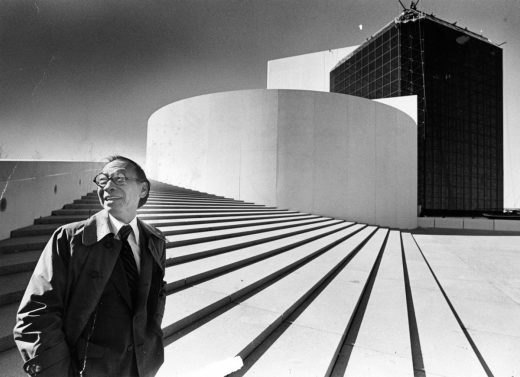
photo : Ted Dully/The Boston Globe via Getty Images
The M+ Cinema will feature a series of special screenings in its Summer Edition from July to September 2024, with a focus on documentary and fiction films featuring Pei’s architectural projects. Highlights include First Person Singular: I. M. Pei (1997), an insightful documentary in which Pei leads viewers on an international tour of his best-known works with candid discussions of his life and design approach; Paul Verhoeven’s sci-fi classic RoboCop (1987), featuring Dallas City Hall (1966–1977) in Texas; and Woody Allen’s comedy Sleeper (1973), shot in part at the National Center for Atmospheric Research (1961–1967) in Boulder, Colorado. From July to December 2024, there will also be free Grand Stair Daytime Screenings featuring two documentaries about Pei’s projects in Asia.
A series of programmes suitable for adults and children will be launched this summer. In Family Day Design Workshop: Re-Create with I. M. Pei, architect Kenrick Wong invites participants to learn about Pei’s iconic works and design thinking through hands-on activities. In Family Day Drop-in: I. M. Pei in Imagination Playground, led by M+ Educators, participants will use modules of various shapes and sizes to create structures following Pei’s approach of conducting design tests with mock-ups. There will be special tours and workshops for the public as well as school, community, and access tours for different audiences.
For details of the public and screening programmes, please refer to Appendix 2. Other programme details will be announced on the M+ website.
Exhibition merchandise
To coincide with the exhibition, a 400-page monograph I. M. Pei: Life Is Architecture with more than 400 colour illustrations will be published in July 2024 by Thames & Hudson in collaboration with M+. The title presents both celebrated and lesser-known aspects of Pei’s life and career by featuring largely unpublished archival materials, newly commissioned photographs and essays, as well as personal anecdotes from scholars and those who knew and worked with Pei. Inspired by Pei’s significant projects, M+ Shop is launching a range of exhibition merchandise, including glass vases, wall clocks, wooden blocks, tote bags, bookmarks, folders, and more. For more product highlights, please refer to the image sheet.
Ticketing arrangements
Tickets to the Special Exhibition are available for online purchase via the M+ website, West Kowloon Cultural District website, West Kowloon Cultural District App, Cityline, hina Travel Service (Hong Kong) Limited, Fliggy, Klook, KKday, and Trip.com. The Special Exhibition ticket is priced at HKD 160 for adults and HKD 80 for visitors eligible for concessions.* Visitors with Special Exhibition tickets can access I. M. Pei: Life Is Architecture and all M+ General Admission exhibitions starting from Saturday, 29 June 2024.For more information on ticketing arrangements, please visit the M+ website.
*Concession tickets are available for full-time students, children ages 7 to 11, senior citizens ages 60 and above, persons with disabilities and one companion, and Comprehensive Social Security Assistance (CSSA) recipients.
Architect Ieoh Ming Pei, selected to design the JFK Memorial Library, USA:
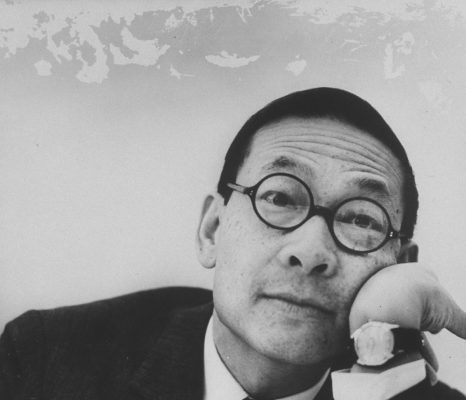
photo :John Loengard/The LIFE Picture Collection/Shutterstock (12028250a)
M+ Membership
M+’s annual membership and patron membership offer an exclusive experience of contemporary visual culture for people of all ages and backgrounds. All M+ Members with valid memberships can enjoy three free admission vouchers to Special Exhibitions throughout the membership year, including I. M. Pei: Life Is Architecture. Meanwhile, M+ Patrons can enjoy unlimited free admission to all exhibitions with up to three guests per visit. M+ Members and Patrons can also enjoy exclusive previews to Special Exhibitions prior to public opening and thirty to fifty per cent discounts on Special Exhibition tickets. Other membership benefits include unlimited free access to General Admission exhibitions, exclusive access to the M+ Lounge, M+ Private Viewing, priority booking of tickets, exclusive events, and more. For more information, please visit the M+ website.
I. M. Pei: Life Is Architecture is generously supported by the Lead Sponsor Bank of China (Hong Kong), Bei Shan Tang Foundation, the Family of S. P. Tao, Travel Partner Cathay, and Hotel Partner The Ritz-Carlton, Hong Kong.
###
About I. M. Pei
Ieoh Ming Pei (1917–2019) was born in Guangzhou before moving to Hong Kong in 1918. Pei spent his teenage years in Shanghai and Suzhou before beginning his architectural education in the United States in 1935.
He completed his undergraduate studies at the Massachusetts Institute of Technology in 1940 and his graduate degree at Harvard University’s Graduate School of Design in 1946. In 1948, Pei headed the architectural division of Webb & Knapp, founded by real estate developer William Zeckendorf, in New York City. There, Pei’s projects included Kips Bay Plaza (1957–1962), Mile High Center (1952–1956), and Society Hill (1957–1964).
I. M. Pei & Associates, informally established in 1955, became independent from Webb & Knapp in 1960. Important commissions included the National Center for Atmospheric Research (1961–1967), Everson Museum of Art (1961–1968), and John F. Kennedy Presidential Library and Museum (1964–1979). The firm was renamed I. M. Pei & Partners in 1966.
The late 1960s was marked by major public commissions like the National Gallery of Art East Building (1968–1978) and Pei’s increasing international presence with projects such as the OCBC Centre (1970–1976), Fragrant Hill Hotel (1979–1982), Bank of China Tower (1982–1989), and the modernisation of the Grand Louvre (1983–1993). Pei became the fifth Pritzker Architecture Prize Laureate in 1983.
In 1990, Pei retired from full-time practice as I. M. Pei & Partners was restructured as Pei Cobb Freed & Partners, but he nevertheless took on projects independently, like the Miho Museum (1991–1997), Suzhou Museum (2000–2006), Museum of Islamic Art (2000–2008), and, lastly, the Miho Institute of Aesthetics Chapel (2008–2012).
About M+
M+ is a museum dedicated to collecting, exhibiting, and interpreting visual art, design and architecture, moving image, and Hong Kong visual culture of the twentieth and twenty-first centuries.
In Hong Kong’s West Kowloon Cultural District, it is one of the largest museums of modern and contemporary visual culture in the world, with a bold ambition to establish ourselves as one of the world’s leading cultural institutions. M+ is a new kind of museum that reflects our unique time and place, a museum that builds on Hong Kong’s historic balance of the local and the international to define a distinctive and innovative voice for Asia’s twenty-first century.
About the West Kowloon Cultural District
The West Kowloon Cultural District is one of the largest and most ambitious cultural projects in the world. Its vision is to create a vibrant new cultural quarter for Hong Kong on forty hectares of reclaimed land located alongside Victoria Harbour. With a varied mix of theatres, performance spaces, and museums, the West Kowloon Cultural District will produce and host world-class exhibitions, performances, and cultural events, providing twenty-three hectares of public open space, including a two-kilometre waterfront promenade.
Previously on e-architect:
May 17, 2019
Architect Ieoh Ming Pei Dies
I.M. Pei Dies aged 102
Ieoh Ming Pei, FAIA, RIBA was born in China in 1917.
The Chinese American architect was born in Guangzhou and raised in Hong Kong and Shanghai, China.
Louvre Pyramid Paris building design by I M Pei Architect:
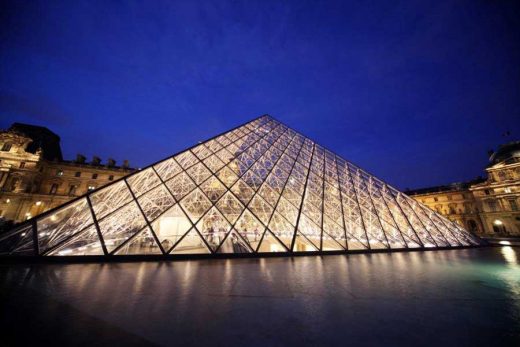
photo © Steven Powell, 2010
He was best known as architect of The Louvre’s crystal pyramid in Paris, the Bank of China Tower in Hong Kong, the Museum of Islamic Art in Doha and the East Building of Washington’s National Gallery of Art.
I M Pei won the Pritzker Architecture Prize in 1983.
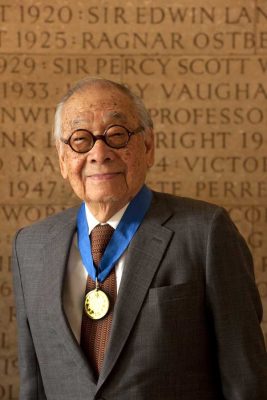
picture from architects office
Architect I M Pei was the RIBA Gold Medal 2010 Winner.
Location: M+, West Kowloon Cultural District, Hong Kong, China, Asia
Background on this Architect
Pei Cobb Freed & Partners studio based in Manhattan, New York City, USA
Ieoh Ming Pei : Pritzker Prize architects Winner 1983
Key Building by I.M. Pei : Museum of Islamic Art Doha
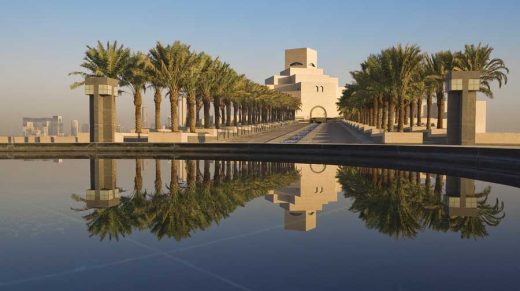
photo : Courtesy of the Museum of Islamic Art
Comments / photos for the I. M. Pei: Life Is Architecture, architect Ieoh Ming retrospective page welcome

